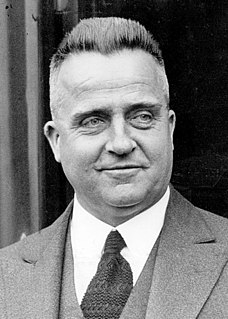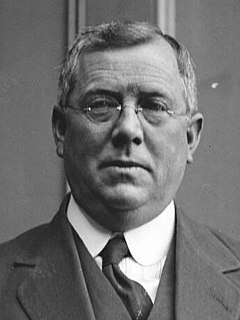
John Thomas Lang, usually referred to as J. T. Lang during his career and familiarly known as "Jack" and nicknamed "The Big Fella", was an Australian politician who twice served as the 23rd Premier of New South Wales from 1925 to 1927 and again from 1930 to 1932. He was dismissed by the Governor of New South Wales, Sir Philip Game, at the climax of the 1932 constitutional crisis and resoundingly lost the resulting election and subsequent elections as Leader of the Opposition. He later formed Lang Labor and was briefly a member of the Australian House of Representatives.

Sir Bertram Sydney Barnsdale Stevens, also referred to as B. S. B. Stevens, was an Australian politician who served as the 25th Premier of New South Wales, in office from 1932 to 1939 as leader of the United Australia Party (UAP).

The 1927 New South Wales state election to elect the 90 members of the 28th Legislative Assembly was held on 8 October 1927. During the previous parliament the voting system, which had been a form of proportional representation with multi-member seats and a single transferable vote, was changed to single member constituencies with optional preferential voting. Severe divisions occurred within the Labor Party caucus in the four months prior to the election and a caretaker government composed of the supporters of the Premier of New South Wales and party leader, Jack Lang was in power at the time of the election.
Members of the New South Wales Legislative Assembly who served in the 27th parliament of New South Wales held their seats from 1925 to 1927. They were elected at the 1925 state election on 30 May 1925. The Speaker was James Dooley.</ref>

The 1925 New South Wales state election was held on 30 May 1925. This election was for all of the 90 seats in the 27th New South Wales Legislative Assembly and was conducted in multiple-member constituencies using the Hare Clark single transferable vote. The 26th parliament of New South Wales was dissolved on 18 April 1925 by the Governor, Sir Dudley de Chair, on the advice of the Premier Sir George Fuller.

The Holman ministry , first Holman ministry or Holman Labor ministry was the 35th ministry of the New South Wales Government, and was led by the 19th Premier, William Holman.

The Storey ministry was the 37th ministry of the New South Wales Government, and was led by the 20th Premier, John Storey.

The Dooley ministry (1921) or the first Dooley ministry was the 38th ministry of the New South Wales Government, and was led by the 21st Premier, James Dooley. It was the first of two occasions that Dooley was Premier.

The Dooley ministry (1921–1922) or the Second Dooley ministry was the 40th ministry of the New South Wales Government, and was led by the 21st Premier, James Dooley.

The Fuller ministry (1921) or First Fuller ministry was the 39th ministry of the New South Wales Government, and was led by the 22nd Premier, Sir George Fuller. The ministry covers just seven hours during 20 December 1921, the shortest of any ministry in the history of self-government in the state.

The Fuller ministry (1922–1925) or Second Fuller ministry was the 41st ministry of the New South Wales Government, and was led by the 22nd Premier, Sir George Fuller. This ministry was the second of two occasions where Fuller was Premier.

The Lang ministry (1925–1927) or First Lang ministry was the 42nd ministry of the New South Wales Government, and was led by the 23rd Premier, Jack Lang. This ministry was the first of three ministries under Lang as Premier.

The Lang ministry (1930–1932) or Third Lang ministry was the 45th ministry of the New South Wales Government, and was led by the 23rd Premier, Jack Lang. This ministry was the third and final time of three occasions where Lang was Premier.

The Bavin ministry was the 44th ministry of the New South Wales Government, and was led by the 24th Premier, Thomas Bavin, in a Nationalist coalition with the Country Party, led by Ernest Buttenshaw.

The Stevens–Bruxner ministry (1932–1935) or First Stevens–Bruxner ministry or First Stevens ministry was the 46th ministry of the New South Wales Government, and was led by the 25th Premier, Bertram Stevens, in a United Australia Party coalition with the Country Party, that was led by Lieutenant-Colonel Michael Bruxner, DSO. The ministry was one of three occasions when the Government was led by Stevens, as Premier; and one of four occasions where Bruxner served as Deputy Premier.

The Stevens–Bruxner ministry (1938–1939) or Third Stevens–Bruxner ministry or Third Stevens ministry was the 48th ministry of the New South Wales Government, and was led by the 25th Premier, Bertram Stevens, in a United Australia Party coalition with the Country Party, that was led by Michael Bruxner. The ministry was the third of three occasions when the Government was led by Stevens, as Premier; and third of four occasions where Bruxner served as Deputy Premier.

The McKell ministry (1941–1944) or First McKell ministry was the 50th ministry of the New South Wales Government, and was led by the 27th Premier, William McKell, of the Labor Party. The ministry was the first of two occasions when the Government was led by McKell, as Premier.

The McKell ministry (1944–1947) or Second McKell ministry was the 51st ministry of the New South Wales Government, and was led by the 27th Premier, William McKell, of the Labor Party. The ministry was the second of two occasions when the Government was led by McKell, as Premier.
Members of the New South Wales Legislative Council who served from 1925 to 1927 were appointed for life by the Governor on the advice of the Premier. This list includes members between the 1925 state election on 30 May 1925 and the 1927 state election on 8 October 1927. The President was Fred Flowers. Magrath appointed, Roberts died, Tyrrell appointed, Wilson died, Dodd died, 23 appointed, Ainsworth appointed, Dickson appointed, 2 expelled, 5 expelled, Brown died, Hordern died, White died, </ref></ref> The Labor platform included the abolition of the Legislative Council. At the opening of the new parliament on 24 June 1925 there were 75 members of the council, with just 23 Labor members and Premier Jack Lang had been seeking to appoint 25 new members, however the Governor Sir Dudley de Chair had declined to do so in September 1925. In December the Governor agreed to make the appointments in circumstances that are disputed. De Chair understood there was an agreement that the appointments would not be used to abolish the Legislative Council, while Lang said he gave no such undertaking. All 25 appointees took the pledge to implement the Labor platform, "including the abolition of the Legislative Council", similar to that signed by other Labor members.
Members of the New South Wales Legislative Council who served from 1913 to 1917 were appointed for life by the Governor on the advice of the Premier. This list includes members between the election on 6 December 1913 and the election on 24 March 1917. The President was Sir Francis Suttor until his death in April 1915 and then Fred Flowers.</ref>









